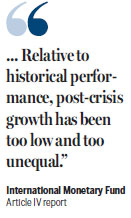IMF forecasts lower US GDP
The International Monetary Fund on Tuesday cut its forecast for US GDP growth despite the country's long economic expansion and return to full employment.
It now predicts that the US economy will grow 2.1 percent in 2017 and 2018, from the 2.3 percent and 2.5 percent, respectively, in a forecast made earlier this year, according to the IMF Article IV report, which was conducted annually in assessing the health of an economy through consultation with its government.
The growth forecast for the US economy in 2019 and 2020 is 1.9 percent and 1.8 percent, respectively.
Alejandra Werner, director of the IMF Western Hemisphere Department, told a press conference on Tuesday that the January update to mark up the US growth forecast was made by incorporating an assumed fiscal stimulus that would roll out over the next few years.

"However, after discussions with the US authorities, and given the still-evolving policy plans, we have decided to remove that assumed stimulus from our forecast and base our projections on unchanged policies," he said.
Werner said that it reflects uncertainty about the macroeconomic policies that will be put in place in the coming months.
"As a result of the change in assumptions, we have lowered our near-term growth projection relative to that which was published in the April World Economic Outlook," he said.
The report released on Tuesday started with a positive note, praising the US economy as in its third-longest expansion since 1850. Real gross domestic product is now 12 percent higher than its pre-recession peak; job growth has been persistently strong; and although there are measurement uncertainties, the US economy appears to be back at full employment.
But the US economic model is not working as well as it could in generating broadly shared income growth, the report said. The nation also is burdened by rising debt.
The US dollar is moderately overvalued by around 10-20 percent. The external position is moderately weaker than implied by medium-term fundamentals and desirable policies, according to the report.
It also noted that the current account (trade) deficit is expected to be around 3 percent of GDP over the medium term, and the net international investment position has deteriorated markedly in the past several years.
"Most critically, relative to historical performance, post-crisis growth has been too low and too unequal," the report said.
"As we have emphasized in past consultations, these include: generating faster economic and productivity growth, stimulating job creation, incentivizing business investment, balancing the budget and bringing down the public debt, and creating the fiscal space that is needed to finance priorities such as infrastructure and investments in human capital," Werner said.
chenweihua@chinadailyusa.com
(China Daily USA 06/28/2017 page2)
















